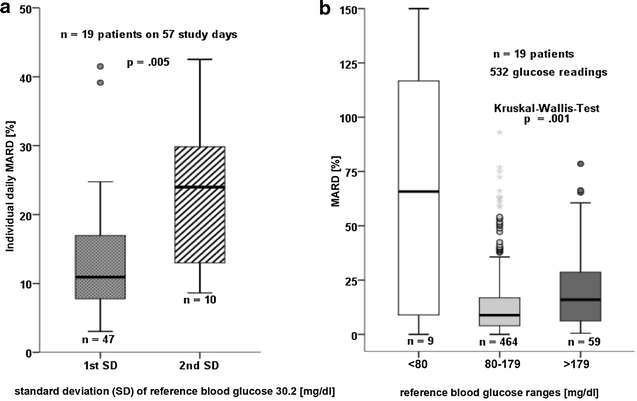Accuracy, reliability, feasibility and nurse acceptance of a subcutaneous continuous glucose management system in critically ill patients: a prospective clinical trial
- PMID: 27439710
- PMCID: PMC4954792
- DOI: 10.1186/s13613-016-0167-z
Accuracy, reliability, feasibility and nurse acceptance of a subcutaneous continuous glucose management system in critically ill patients: a prospective clinical trial
Abstract
Background: Continuous glucose monitoring (CGM) has not yet been implemented in the intensive care unit (ICU) setting. The purpose of this study was to evaluate reliability, feasibility, nurse acceptance and accuracy of the Medtronic Sentrino(®) CGM system in critically ill patients.
Methods: Sensors were inserted into the subcutaneous tissue of the patient's thigh, quantifying interstitial glucose concentration for up to 72 h per sensor. Reliability and feasibility analysis included frequency of data display, data gaps and reasons for sensor removal. We surveyed nurse acceptance in a questionnaire. For the accuracy analysis, we compared sensor values to glucose values obtained via blood gas analysis. Potential benefits of CGM were investigated in intra-individual analyses of factors, such as glycemic variability or time in target range achieved with CGM compared to that achieved with intermittent glucose monitoring.
Results: The device generated 68,655 real-time values from 31 sensors in 20 critically ill patients. 532 comparative blood glucose values were collected. Data were displayed during 32.5 h [16.0/62.4] per sensor, which is 45.1 % of the expected time of 72 h and 84.8 % of 37.9 h actual monitoring time. 21 out of 31 sensors were removed prematurely. 79.1 % of the nursing staff rated the device as not beneficial; the response rate was one-third. Mean absolute relative difference was 15.3 % (CI 13.5-17.0 %). Clarke error grid: 76.9 % zone A, 21.6 % zone B, 0.2 % zone C, 0.9 % zone D, 0.4 % zone E. Bland-Altman plot: mean bias +0.53 mg/dl, limits of agreement +64.6 and -63.5 mg/dl. Accuracy deteriorated during elevated glycemic variability and in the hyperglycemic range. There was no reduction in dysglycemic events during CGM compared to 72 h before and after CGM. If CGM was measuring accurately, it identified more hyperglycemic events when compared to intermittent measurements. This study was not designed to evaluate potential benefits of CGM on glucose control.
Conclusions: The subcutaneous CGM system did not perform with satisfactory accuracy, feasibility, or nursing acceptance when evaluated in 20 medical-surgical ICU patients. Low point accuracy and prolonged data gaps significantly limited the potential clinical usefulness of the CGM trend data. Accurate continuous data display, with a MARD < 14 %, showed potential benefits in a subgroup of our patients. Trial registration NCT02296372; Ethic vote Charité EA2/095/14.
Keywords: Accuracy; Continuous glucose monitoring; Critically ill patients; Evaluation; Feasibility; ICU; Interstitial; Medtronic Sentrino®; Nurse acceptance; Reliability; Subcutaneous.
Figures




Similar articles
-
Continuous Glucose Monitoring in Critically Ill Patients With COVID-19: Results of an Emergent Pilot Study.J Diabetes Sci Technol. 2020 Nov;14(6):1065-1073. doi: 10.1177/1932296820964264. Epub 2020 Oct 16. J Diabetes Sci Technol. 2020. PMID: 33063556 Free PMC article.
-
Performance of the Medtronic Sentrino continuous glucose management (CGM) system in the cardiac intensive care unit.BMJ Open Diabetes Res Care. 2014 Jul 21;2(1):e000037. doi: 10.1136/bmjdrc-2014-000037. eCollection 2014. BMJ Open Diabetes Res Care. 2014. PMID: 25452874 Free PMC article.
-
Accuracy and reliability of a subcutaneous continuous glucose monitoring device in critically ill patients.J Clin Monit Comput. 2018 Oct;32(5):953-964. doi: 10.1007/s10877-017-0086-z. Epub 2017 Dec 7. J Clin Monit Comput. 2018. PMID: 29218549 Clinical Trial.
-
Accuracy of Freestyle Libre continuous glucose monitoring system in critically ill patients after cardiac surgery.J Cardiothorac Surg. 2025 Jan 20;20(1):75. doi: 10.1186/s13019-024-03229-1. J Cardiothorac Surg. 2025. PMID: 39833920 Free PMC article. Review.
-
Accuracy of continuous glucose monitoring systems in intensive care unit patients: a scoping review.Intensive Care Med. 2024 Dec;50(12):2005-2018. doi: 10.1007/s00134-024-07663-6. Epub 2024 Oct 17. Intensive Care Med. 2024. PMID: 39417874
Cited by
-
Diabetes Technology Update: Use of Insulin Pumps and Continuous Glucose Monitoring in the Hospital.Diabetes Care. 2018 Aug;41(8):1579-1589. doi: 10.2337/dci18-0002. Epub 2018 Jun 23. Diabetes Care. 2018. PMID: 29936424 Free PMC article. Review.
-
Consensus Statement on Inpatient Use of Continuous Glucose Monitoring.J Diabetes Sci Technol. 2017 Sep;11(5):1036-1044. doi: 10.1177/1932296817706151. Epub 2017 Apr 21. J Diabetes Sci Technol. 2017. PMID: 28429611 Free PMC article.
-
Assessment of changes in blood glucose concentration with intravascular microdialysis.J Clin Monit Comput. 2018 Dec;32(6):1135-1142. doi: 10.1007/s10877-018-0111-x. Epub 2018 Feb 5. J Clin Monit Comput. 2018. PMID: 29404891
-
The Clinical Benefits and Accuracy of Continuous Glucose Monitoring Systems in Critically Ill Patients-A Systematic Scoping Review.Sensors (Basel). 2017 Jan 14;17(1):146. doi: 10.3390/s17010146. Sensors (Basel). 2017. PMID: 28098809 Free PMC article.
-
Implementation of Continuous Glucose Monitoring in Critical Care: A Scoping Review.Curr Diab Rep. 2023 Jun;23(6):69-87. doi: 10.1007/s11892-023-01503-5. Epub 2023 Apr 13. Curr Diab Rep. 2023. PMID: 37052790 Free PMC article.
References
Associated data
LinkOut - more resources
Full Text Sources
Other Literature Sources
Medical

